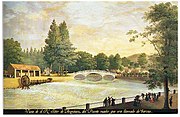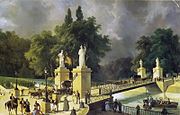Puente de Barcas (Aranjuez)
Coordinates: 40 ° 2 ′ 13 ″ N , 3 ° 36 ′ 18 ″ W.
| Puente de Barcas | ||
|---|---|---|
| use | Road bridge | |
| Convicted |
|
|
| Crossing of | Tagus | |
| place | Aranjuez | |
| location | ||
|
|
||
The Puente de Barcas ( Spanish ship bridge ) is the most important road bridge over the Tajo in Aranjuez in Spain . It leads the Carretera de Madrid coming from the north over the river to the Plaza de Rusiñol directly at the Jardin del Parterre (garden parterre) in front of the Palacio Real .
Surname
The name goes back to the original ship bridge, which was also retained for the various successors in the same place.
history
Original ship bridges
On the way from Madrid, the access to the royal summer residence initially consisted of avenues and two wooden bridges over the Tagus and its branch. However, this access was reserved for members of the court and foreign envoys. Since there were only a few houses outside the residence and no overnight accommodation, that hardly bothered.
It was not until 1656 that Philip IV had a ship bridge built for general use outside the royal gardens. It stood near the small wooden bridge that Don Gonzalo Chacon had built for his water mill on the right bank of the river. Their lane was around 35 m long and 7 m wide and lay on four ships. Juan de Villanueve later changed it to a three-aisle bridge, which also had iron railings. Their maintenance was expensive, as the ships had to be renewed regularly. But no one wanted to build a permanent bridge, as its large arch would have disturbed the view from the palace.
Arch bridge
At the end of the 18th century, a bridge was built that crossed the river with three arches. Their lane rose relatively steeply towards the middle, which was not easy for carriages. The narrow passage between the two pillars was only possible with caution for the royal barge . It was destroyed by English troops in 1810 and replaced with a temporary solution.
Vista del Puente nuevo que era llmado de Barcas (View of the new bridge called Puente de Barcas) by Fernando Brambilla (1763–1834)
Puente Colgado
Between 1819 and 1834 Pedro Miranda built the Puente Colgado , one of the first chain bridges ( Spanish puente colgante ) in Spain and the first for carriage traffic. The expression Puente Colgado became the common name for chain and suspension bridges in the 19th century. In Aranjuez he apparently went to the Puente Colgado back, a hanging truss bridge , the end of the 18th century, a former bridge to the Jardin de la Isla replaced (at the site of today's Puente de enmedio ).
It had a level carriageway that continued the street level, which the carriages could use without hindrance. With a span of 35 m, it did not need any pillars in the river. It had three wrought-iron chains to which the roadway was fastened with iron hangers, and four large towers made of stone masonry, which were decorated with large statues.
Steel arch bridge
In 1930 the Puente Colgado was replaced by a steel arch bridge with a wider carriageway.
Current bridge
In 1968 the increase in traffic required a new building. The current bridge has four lanes and walkways on both sides, the one on the side facing the palace being 6 m wide. The bridge is a plate-girder bridge made of reinforced concrete.
Web links
- Puente de Barcas on aranjuezhistoriagrafica.com
Individual evidence
- ^ Johann Jacob Volkmann: Recent journeys through Spain . excellent in respect of the arts, action, economy and manufacture. tape 1 . Caspar Fritsch, Leipzig 1785, p. 356 ( full text in Google Book Search).
- ↑ The buildings of the company, which had grown into a larger mill, were only demolished a few years ago.
- ↑ Juan Antonio Álvarez de Quindós y Baena: Descripcion histórica del real bosque y casa de Aranjuez . Imprenia Real, Madrid 1804, p. 277 ( full text in Google Book Search).
- ↑ a b Puente de Barcas on aranjuezhistoriagrafica.com
- ↑ Leonardo Fernández Troyano, Amaya Sáenz Sanz: Los puentes: materiales, estructuras y patrimonio . In: Manuel Silva Suárez (ed.): Técnica e ingeniería en España: El Ochocientos: de los lenguajes al patrimonio . tape 6 . Prensas universitarias de Zaragoza, Zaragoza 2011, ISBN 978-84-9911-151-3 , pp. 452 ( limited preview in Google Book search).
- ↑ Plate No. 62 = Real Sitio de Aranjuez - 6. Vista del puente colgado con parte del jardin de la Isla from Vistas de los Sitios Reales y Madrid by Fernando Brambila. In: Biblioteca Digital Hispánica





